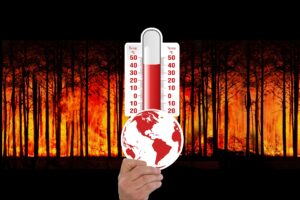In a sobering forecast from the UK’s Met Office, 2024 is predicted to mark a historic moment in climate history as it could become the first year to surpass the 1.5°C warming limit set by global officials in the Paris Agreement. This milestone, while not constituting a breach of the agreement, underscores the urgency of addressing climate change.
The Paris Agreement, established in 2015, aimed to prevent global temperatures from exceeding 1.5°C above pre-industrial levels. Nick Dunstone, a researcher at the Met Office, acknowledges that a temporary exceedance won’t violate the agreement but emphasizes the significance of crossing this threshold. “The first year above 1.5°C would certainly be a milestone in climate history,” Dunstone states.
The Met Office’s forecast indicates a 27% chance of 2024 surpassing the 1.5°C mark, but Dunstone urges caution in interpreting this figure. The unpredicted warmth of 2023, which exceeded Met Office predictions, introduces uncertainty into future forecasts. The unexpected heat in 2023 is attributed to factors like a strengthening El Niño, volcanic activity in Tonga, and unexplained warmth in the southern hemisphere.
The El Niño, characterized by changing winds spreading warm waters across the Pacific, temporarily influences global temperatures. Additionally, the eruption of a submerged volcano injected water vapor into the stratosphere, contributing to warming. The southern hemisphere’s higher-than-expected temperatures further complicate predictions.
The forecast for 2024 starts from the current observed warming level but may underestimate the actual temperature if the factors influencing 2023 persist. Long-term warming trends are unequivocally linked to rising greenhouse gas emissions. While fluctuations, like the potential cooling post-2024 due to the ending of El Niño, may occur, the long-term average is projected to breach the 1.5°C limit by 2030, as defined by the Paris Agreement.
Notably, the forecasted exceedance is part of an overarching trend. January 2016, during a robust El Niño, was the first month to breach the 1.5°C threshold. Subsequent months, particularly February 2016, saw even higher anomalies. In 2021, November witnessed the first day with an anomaly exceeding 2°C, emphasizing the accelerating pace of climate change.
This sobering projection serves as a poignant reminder of the imperative to address climate change promptly. As nations grapple with the consequences of rising temperatures, the race against time to mitigate and adapt to climate challenges intensifies. The global community faces a crucial juncture, reinforcing the need for sustained efforts to curb emissions and foster sustainable practices. The specter of surpassing the 1.5°C mark looms large, urging collective action to safeguard the planet for future generations.


Pingback: Urban Energy Solutions: The Ascendancy of Sustainable Cities and Communities - Genviss : Engineering Sustainable Solutions for Water, Energy, and the Environment